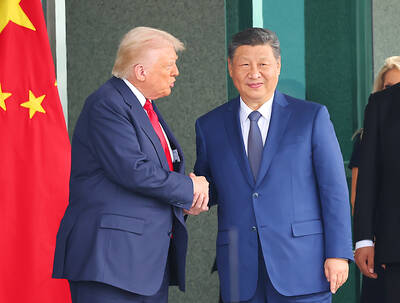If the plan to build Kuokuang Petrochemical Technology Co’s (國光石化) naphtha cracker plant in Taiwan is scrapped, it would have a positive influence on the nation’s economy in the long term, economists said yesterday.
Premier Wu Den-yih (吳敦義) said on Saturday that Kuokuang Petrochemical might seek an alternative location overseas for its proposed plant, after President Ma Ying-jeou (馬英九) said on Friday that the government would not support the construction of the company’s project in Changhua County.
GDP growth could fall by 2 percentage points if the plant’s construction in Taiwan is halted because domestic investment momentum could drop without the NT$900 billion (US$31.11 billion) two-phase project, not to mention the economic spin-off effects, the Ministry of Economic Affairs said last week.
However, Gordon Sun (孫明德), deputy director of the macroeconomic forecasting center at the Taiwan Institute of Economic Research (TIER, 台灣經濟研究院), said any negative impact on GDP growth could be compensated for with the government’s other -investment projects.
“If Kuokuang Petrochemical’s project is out, the government could come up with projects or construction in other industries and transfer the NT$900 billion investment to them, keeping up the momentum in domestic investment,” Sun said by telephone yesterday.
Furthermore, the ministry’s forecast that 2 percentage points could be shaved off GDP growth would be a long-term effect spread over five to eight years, not just one year, Sun said.
Liang Kuo-yuan (梁國源), president of the Polaris Research Institute (寶華綜合經濟研究院), said that any potential withdrawal of Kuokuang Petrochemical’s investment from Taiwan would only have a limited impact on GDP growth.
“External demand could be -impacted if the project is halted, but the benefits for the local natural environment and water quality could offset this negative impact, as the macroeconomics not only include GDP growth, but also the potential negative consequences brought about by the execution of the project,” Liang told the Taipei Times.
Diagee Shaw (蕭代基), president of the Chung-Hua Institution for Economic Research (中華經濟研究院), said the potential withdrawal of the project could inspire the government into thinking that the development of the petrochemical industry should focus on quality, not just quantity.
The government is now seeking to develop a value-added petrochemical industry, such as the production of optical coatings and upstream materials for solar energy and LED industries, Minister of Economic Affairs Shih Yen-shiang (施顏祥) told a media briefing on Saturday.
Sun agreed that Taiwan could develop a high-end petrochemical industry by applying its successful development experience in the development of its semiconductor foundry industry.
“We should let investments in low-value and high-contamination sectors be made overseas, while retaining the value-added sectors here,” Sun said.
The government should also consider transferring the budgeted funds for the Kuokuang project to bio-technology, tourism and other manufacturing industries with value-added components, compensating for any potential dip in GDP growth, should the project be withdrawn, Sun said.

RUN IT BACK: A succesful first project working with hyperscalers to design chips encouraged MediaTek to start a second project, aiming to hit stride in 2028 MediaTek Inc (聯發科), the world’s biggest smartphone chip supplier, yesterday said it is engaging a second hyperscaler to help design artificial intelligence (AI) accelerators used in data centers following a similar project expected to generate revenue streams soon. The first AI accelerator project is to bring in US$1 billion revenue next year and several billion US dollars more in 2027, MediaTek chief executive officer Rick Tsai (蔡力行) told a virtual investor conference yesterday. The second AI accelerator project is expected to contribute to revenue beginning in 2028, Tsai said. MediaTek yesterday raised its revenue forecast for the global AI accelerator used

TEMPORARY TRUCE: China has made concessions to ease rare earth trade controls, among others, while Washington holds fire on a 100% tariff on all Chinese goods China is effectively suspending implementation of additional export controls on rare earth metals and terminating investigations targeting US companies in the semiconductor supply chain, the White House announced. The White House on Saturday issued a fact sheet outlining some details of the trade pact agreed to earlier in the week by US President Donald Trump and Chinese President Xi Jinping (習近平) that aimed to ease tensions between the world’s two largest economies. Under the deal, China is to issue general licenses valid for exports of rare earths, gallium, germanium, antimony and graphite “for the benefit of US end users and their suppliers

Dutch chipmaker Nexperia BV’s China unit yesterday said that it had established sufficient inventories of finished goods and works-in-progress, and that its supply chain remained secure and stable after its parent halted wafer supplies. The Dutch company suspended supplies of wafers to its Chinese assembly plant a week ago, calling it “a direct consequence of the local management’s recent failure to comply with the agreed contractual payment terms,” Reuters reported on Friday last week. Its China unit called Nexperia’s suspension “unilateral” and “extremely irresponsible,” adding that the Dutch parent’s claim about contractual payment was “misleading and highly deceptive,” according to a statement

Artificial intelligence (AI) giant Nvidia Corp’s most advanced chips would be reserved for US companies and kept out of China and other countries, US President Donald Trump said. During an interview that aired on Sunday on CBS’ 60 Minutes program and in comments to reporters aboard Air Force One, Trump said only US customers should have access to the top-end Blackwell chips offered by Nvidia, the world’s most valuable company by market capitalization. “The most advanced, we will not let anybody have them other than the United States,” he told CBS, echoing remarks made earlier to reporters as he returned to Washington